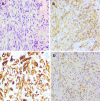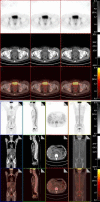Kaposi's sarcoma manifested as lower gastrointestinal bleeding in a HIV/HBV-co-infected liver cirrhosis patient: A case report
- PMID: 31624759
- PMCID: PMC6795727
- DOI: 10.12998/wjcc.v7.i19.3090
Kaposi's sarcoma manifested as lower gastrointestinal bleeding in a HIV/HBV-co-infected liver cirrhosis patient: A case report
Abstract
Background: Kaposi's sarcoma (KS) is one of the most common cancers in human immunodeficiency virus (HIV)-positive patients and leads to a high prevalence of morbidity and mortality. It usually appears as cutaneous or mucous lesions. Patients with visceral KS are asymptomatic and clinically silent. As the disease advances, patients may progress from a normal condition to exhibiting severe symptoms.
Case summary: A 27-year-old man presented with a 2-mo history of fever, bearing-down pain, and rectal bleeding. His hepatitis B virus DNA level was 2.7 ×107 IU/mL. Abdominal computed tomography (CT) indicated liver cirrhosis. Before he was admitted to our hospital, he was diagnosed with HIV infection. His CD4 count was 24 cells/μL. Pelvic cavity CT suggested a thickened rectum wall accompanied by multiple enlarged lymph nodes. The patient was initially treated as having haemorrhoidal varices with bleeding, telbivudine for anti-hepatitis B virus treatment, and antibiotics for anti-infection. After half a month of treatment, the patient felt that his lower lumbus ache and bearing-down pain had not improved, and a colonoscopy was conducted. The result revealed a rectal mass that was histologically confirmed as KS with rectal spindle cells that were positive for cluster of differentiation 117 (CD117), CD34, human herpes virus 8, and CD31. He was administered systemic chemotherapy with 36 mg/d liposomal doxorubicin six times. The patient experienced no sign of lower gastrointestinal bleeding again.
Conclusion: This case highlights the diagnosis of primary KS with lower gastrointestinal bleeding in HIV-positive patients, which means visceral KS could not be excluded. The gold standard relies on colonoscopy and biopsy findings.
Keywords: Case report; Colonoscopy; Human immunodeficiency virus/hepatitis B virus co-infection; Immunohistochemistry; Kaposi’s Sarcoma; Lower gastrointestinal bleeding.
©The Author(s) 2019. Published by Baishideng Publishing Group Inc. All rights reserved.
Conflict of interest statement
Conflict-of-interest statement: The authors declare that they have no conflicts of interest.
Figures




Similar articles
-
Recurrent lower gastrointestinal bleeding due to primary colonic Kaposi's sarcoma in a patient with AIDS.Int J STD AIDS. 2013 Nov;24(11):908-11. doi: 10.1177/0956462413487517. Epub 2013 Aug 5. Int J STD AIDS. 2013. PMID: 23970616
-
Hidden disseminated extracutaneous AIDS-related Kaposi sarcoma.IDCases. 2020 Feb 10;19:e00716. doi: 10.1016/j.idcr.2020.e00716. eCollection 2020. IDCases. 2020. PMID: 32099811 Free PMC article.
-
Kaposi's sarcoma and HTLV-III: a study in Nigerian adult males.J R Soc Med. 1986 Sep;79(9):510-4. doi: 10.1177/014107688607900905. J R Soc Med. 1986. PMID: 3021963 Free PMC article.
-
[Two HHV8-related illnesses in a HIV-negative patient: Kaposi's sarcoma and multicentric Castleman's disease. Response to treatment with Rituximab and CHOP].Actas Dermosifiliogr. 2006 Jul-Aug;97(6):385-90. doi: 10.1016/s0001-7310(06)73425-1. Actas Dermosifiliogr. 2006. PMID: 16956518 Review. Spanish.
-
Vertebral Lesions from AIDS-Related Kaposi's Sarcoma.Curr HIV Res. 2011 Jun;9(4):270-5. doi: 10.2174/157016211796320342. Curr HIV Res. 2011. PMID: 21631426 Review.
References
-
- Cancian L, Hansen A, Boshoff C. Cellular origin of Kaposi's sarcoma and Kaposi's sarcoma-associated herpesvirus-induced cell reprogramming. Trends Cell Biol. 2013;23:421–432. - PubMed
-
- Scadden DT. AIDS-related malignancies. Annu Rev Med. 2003;54:285–303. - PubMed
-
- Hengge UR, Ruzicka T, Tyring SK, Stuschke M, Roggendorf M, Schwartz RA, Seeber S. Update on Kaposi's sarcoma and other HHV8 associated diseases. Part 1: epidemiology, environmental predispositions, clinical manifestations, and therapy. Lancet Infect Dis. 2002;2:281–292. - PubMed
-
- Hengge UR, Ruzicka T, Tyring SK, Stuschke M, Roggendorf M, Schwartz RA, Seeber S. Update on Kaposi's sarcoma and other HHV8 associated diseases. Part 2: pathogenesis, Castleman's disease, and pleural effusion lymphoma. Lancet Infect Dis. 2002;2:344–352. - PubMed
Publication types
LinkOut - more resources
Full Text Sources
Research Materials

